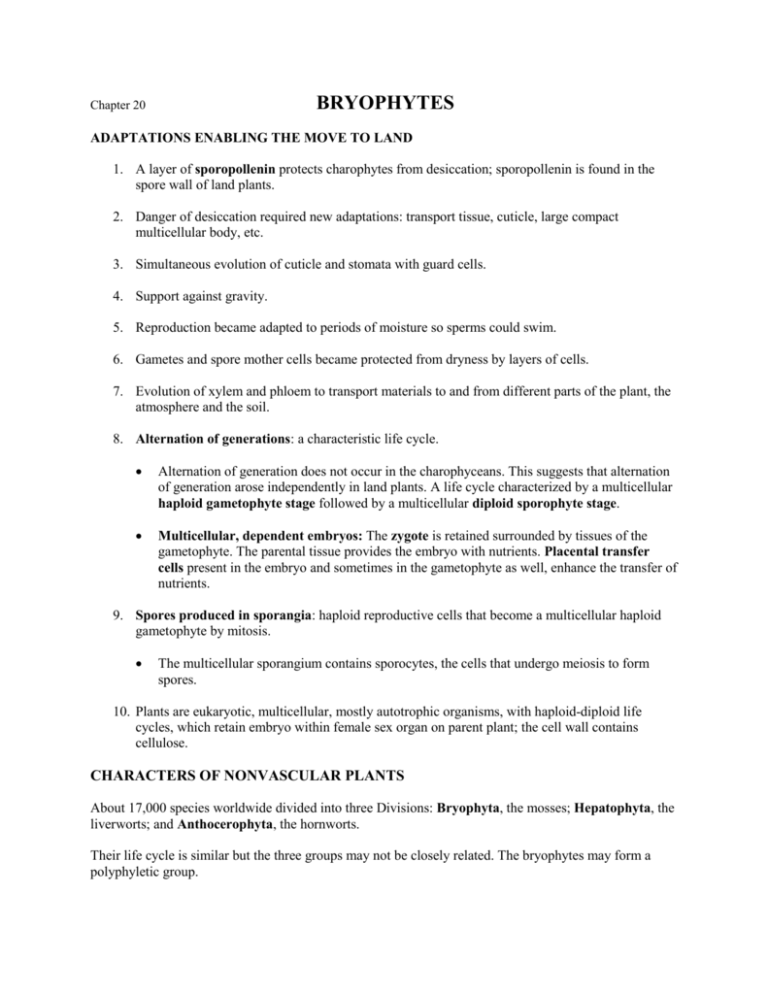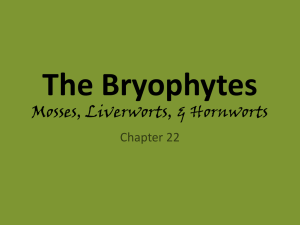Chapter 20 NONVASCULAR PLANTS
advertisement

BRYOPHYTES Chapter 20 ADAPTATIONS ENABLING THE MOVE TO LAND 1. A layer of sporopollenin protects charophytes from desiccation; sporopollenin is found in the spore wall of land plants. 2. Danger of desiccation required new adaptations: transport tissue, cuticle, large compact multicellular body, etc. 3. Simultaneous evolution of cuticle and stomata with guard cells. 4. Support against gravity. 5. Reproduction became adapted to periods of moisture so sperms could swim. 6. Gametes and spore mother cells became protected from dryness by layers of cells. 7. Evolution of xylem and phloem to transport materials to and from different parts of the plant, the atmosphere and the soil. 8. Alternation of generations: a characteristic life cycle. Alternation of generation does not occur in the charophyceans. This suggests that alternation of generation arose independently in land plants. A life cycle characterized by a multicellular haploid gametophyte stage followed by a multicellular diploid sporophyte stage. Multicellular, dependent embryos: The zygote is retained surrounded by tissues of the gametophyte. The parental tissue provides the embryo with nutrients. Placental transfer cells present in the embryo and sometimes in the gametophyte as well, enhance the transfer of nutrients. 9. Spores produced in sporangia: haploid reproductive cells that become a multicellular haploid gametophyte by mitosis. The multicellular sporangium contains sporocytes, the cells that undergo meiosis to form spores. 10. Plants are eukaryotic, multicellular, mostly autotrophic organisms, with haploid-diploid life cycles, which retain embryo within female sex organ on parent plant; the cell wall contains cellulose. CHARACTERS OF NONVASCULAR PLANTS About 17,000 species worldwide divided into three Divisions: Bryophyta, the mosses; Hepatophyta, the liverworts; and Anthocerophyta, the hornworts. Their life cycle is similar but the three groups may not be closely related. The bryophytes may form a polyphyletic group. Bryophyta refers to the phylum of mosses only; bryophytes refer to the three phyla mentioned above. In many respects, bryophytes are transitional between charophycean green algae and the vascular plants discussed later in the course. Characteristics: 1. Small embryophytes found in moist environments, lack woody tissue and xylem and phloem; they usually form mats spread over the ground. 2. Gametophyte generation is dominant; sporophyte is parasitic on the gametophyte. 3. Bryophytes have cuticle, stomata and multicellular gametangia and sporangia that allow them to survive on land. 4. Their bodies are composed of true parenchyma derived from three-dimensional growth usually from an apical meristem. 5. Bryophytes need water to reproduce and most species lack vascular tissue (xylem and phloem). 6. Water transport is mostly through capillary action, diffusion and cytoplasmic streaming. They lack true roots, stems and leaves. The gametophyte of mosses is a one-cell-thick filament known as the protonema that eventually produces buds having meristematic tissue. These meristems produce an upright structure called the gametophore. These gametophytes are one to a few cells thick and obtain nutrients and water by direct absorption from the environment. Most mosses do not have conducting tissue. Some species have specialized cells that conduct water and nutrients but lack lignin in their cell walls. The gametophores are anchored by fragile rhizoids. Rhizoids are either single elongated cells as those found in liverworts and hornworts, or filaments of cells as those of mosses. Rhizoids are not made of tissues and do not absorb any significant amount of water. In that way they differ from roots. Bryophytes have smallest and simplest sporophyte of any group. The sporophyte remains attached to the gametophyte throughout its lifetime, dependent of the gametophyte for food, water and minerals. The mature sporophyte of mosses consists of a foot embedded in the archegonium, a seta or stalk is present in the phylum Bryophyta, and a capsule or sporangium. The cap or calyptra closes the peristome or opening or the capsule. Division Bryophyta Mosses are a large phylum containing about 12,000 species. Many new species are discovered every year in the tropics. The phylum is divided into three classes, Sphagnosida (peat mosses), Andreaeopsida (granite mosses) and Bryopsida (true mosses). The class Bryidae contains about 9,500 species. CHARACTERISTICS Protonema gives rise to gametophores, leafy shoots that produce gametangia. Protonema chlorophyllous with multicellular rhizoids. Gametophyte may or may not branch. Gametophores derive from an apical meristem that has a large apical cell. Derivative cells subdivide and produce the tissues of stems and blades in rather precise arrangement. Gametophore leafy with more than three ranks of blades. Axis with thick walled outer cortical cells and a central strand of smaller cells. Lamina sessile, entire, seldom lobed, one cell thick. Midrib composed of several layers. Laminar cells elongated; hyaline cells: dead, large, barrel-shaped, retain large quantities of water... In the family Polytrichaceae, the lamina bears long sheets of cells (lamellae) on the upper surface that greatly increases the volume of photosynthetic tissue. Cuticle exists only on the upper surface of the blades; the underside lacks cuticle and is capable of absorbing water directly from the environment. Stomata are absent on blades but present on the sporangial wall. Paraphyllia present in some species: small, branched, uniseriate structures. Water transport 1. In some mosses, primarily in the family Polytrichaceae, the innermost cortex is composed of cells called hydroids that conduct water and dissolved minerals. Elongated cells that loose their cytoplasm at maturity. End walls are partially digested but are not removed completely. Each hydroids are aligned with those above and below it 2. Species that have hydroids typically have leptoids. Leptoids resemble sieve cells. Elongated cells. Lack nuclei at maturity but retain some cytoplasm. Have prominent interconnections with adjacent cells. 3. Adjacent parenchyma cells are unusually cytoplasmic and rich in enzymes just as are companion cells. The majority of mosses lack hydroids and leptoids. Water is conducted long the exterior of their stems by capillary action. In species that lack leptoids, sugar is transported by slow transport between the cells. At the base of the axis, rhizoids anchor the plant but do not absorb water or nutrients. Multicellular filaments They lack chloroplasts Development Spores germinate and send out a long chlorophyllous cells. This cells undergoes mitosis and produces a branched system of similar cells called the protonema. Nodules of small cytoplasmic cells form on the protonema, organize an apical cell, and then grow upright as a stem with leaves, the gametophore. Protonemata are perennial and can produce many buds. Reproduction All mosses are oogamous; that is they produce a small flagellated sperm and a large non-motile egg. Male and female gametangia, called antheridia and archegonia respectively, covered with a protective layer of cells, a sterile jacket layer. Retention of the zygote and developing multicellular embryo within the archegonium of the female gametophyte. Species may be bisexual (antheridia and archegonia on the same gametophore) or unisexual (antheridia and archegonia on separate gametophore). Archegonia apical (acrocarpous) or on reduced branches (pleurocarpous). Sporophyte generation In all embryophytes, the megagamete and subsequently, the zygote, are retained by the gametophyte. Moss gametophytes are large and photosynthetic. Bryophytes have smallest and simplest sporophyte of any group. The sporophyte remains attached to the gametophyte throughout its lifetime, dependent of the gametophyte for food, water and minerals. The mature sporophyte of mosses consists of a foot embedded in the archegonium; a seta or stalk is present in the Division Bryophyta, and a capsule or sporangium. The apex of the sporangium differentiates into a lid-like operculum. The operculum separates from the rest of the sporangium as cells differentiate into teeth called peristome teeth. The calyptra closes the peristome or opening or the capsule. The calyptra is derived from the neck of the archegonium. Sporangium opens by an apical lid beneath which the peristome teeth are present. The peristome teeth bend outward and open the sporangium when the air is dry allowing the spores to escape when they are not sticky and can be easily dispersed by air currents. The teeth bend inward when the air is humid. Columella in the sporangium. Seta long and wiry; sporophyte persists for a long period. Seta elongates before sporangium is fully differentiated. Most mosses are homosporous. A few species produce two kind of spores: large spores that produce gametophytes with archegonia, and small spores that produce gametophores with antheridia. Metabolism and Ecology Leaves of moss gametophores are thin with a cuticle only on the upper surface. Mosses dry out in a few minutes. Several mechanism compensate for the inability of mosses to retain water. Many moss species live in permanent moist environment: cloud forest, near waterfalls, spray zones, etc. Microhabitats, e.g. foot of rocks, shallow depressions of substrate, etc. Some species are tolerant of desiccation. They must maintain at least 30% of their body weight water. Water is absorbed rapidly if it rains or dew forms. Mosses remain active during certain seasons of the year depending on the ecosystem in which they live: Inactive during dry spells during the summer in mild temperate regions. Turgid during winter months in deserts and dry habitats. Activity also varies during the day. Mosses are very resistant to high and low temperatures, and UV radiation. Many moss species remain active during winter months when there is enough moisture even if the temperature is below 0ºC. Moss together with lichen species are the primary colonizers of bear rocks, stone walls and tree trunks. Mosses help to control runoff during rains by absorbing water and holding it like a sponge and then releasing it slowly. DIVISION HEPATOPHYTA There are about 6,000 species of liverworts or hepatics. Most liverwort gametophytes develop directly from spores but some produce protonemata. The gametophyte may be leafy or thalloid. The plant typically is flattened with distinct dorsal and ventral surfaces (dorsiventral). CHARACTERISTICS GAMETOPHYTE GENERATION The gametophyte phase begins with the germination of spores. Protonemata are formed. The protonemata are never long lived or highly ramified like in mosses. After a few cells are produced, and apical cell is formed and the growth of the gametophyte begins. Leafy liverworts There are about 4000 species of leafy liverworts. They are abundant in areas of high humidity and rainfall of the tropics and subtropics. The leafy growth habit consists of three rows of isomorphic leaves or in dorsiventral forms two rows of lateral leaves with or without a reduced row of ventral underleaves. The plant resembles a moss. Leaves generally consist of a single layer of undifferentiated cells, and lack a “midrib”. The apex is rounded while the apex of moss blades are pointed. Oil glands are present in the gametophyte. Antheridia are produced on short side branches with modified leaves called the androecium. A tubular sheath called the perianth surrounds the archegonium. Thalloid liverworts The thalloid liverworts may be complex or simple. The gametophyte is ribbon-like or heart shaped, bilaterally symmetrical. Their body is called a thallus. Growth occurs such that the liverwort creeps along a vertical or horizontal substrate. Branching is dichotomous. Gametophytes grow through the activity of a single apical cell. Complex thalloid liverworts exhibit differentiation of the thallus into strata: An upper photosynthetic region including air chambers or pores. A ventrally storage zone which contains cells with abundant lipid reserve. The lower surface bears rhizoids. Simple thalloid liverworts lack specialized air chambers but may contain bundles of water conducting tissue. The simple thalloid liverworts Riccia and Ricciocarpus grow in damp soil or are aquatic. Riccia may be unisexual or bisexual; Ricciocarpus is bisexual. Reproductive organs are distributed along the dorsal surface of the gametophyte. The sporophyte is deeply embedded in the gametophyte and consists mostly of a sporangium. Marchantia produces the sex organs in specialized structures called gametophores (or gametangiophores). Antheridiophores bear antheridia. Archegoniophores bear archegonia. GAMETOPHYTE GENERATION The sporophyte consists of a short foot, seta and the sporangium covered by a calyptra. The sporangium lacks columella. The sporangium contains spores and elaters to help in scattering the spores. Fragmentation and gemma cups are methods of asexual reproduction. Riccia and Ricciocarpus have a simplified sporophyte. The zygote grows into a spherical mass within the archegonium of the gametophore body. No foot or seta is formed. The inner cells undergo meiosis and form spores. The spores are liberated when the surrounding tissue dies. DIVISION ANTHOCEROPHYTA Hornworts form a small phylum of about 100 species. The gametophyte of hornworts resembles that of liverworts. Liverworts and hornworts are distantly related as shown by being included in separate phyla. They grow hidden among vegetation and seldom grow on rocks or tree trunks. GAMETOPHYTE GENERATION The germinating spore produces three or four protonema cells before the thallus begins to develop. Gametophytic thallus lobed, sometimes branching dichotomously. The thallus becomes round when growing in isolation. Most species have a single chloroplast with pyrenoid in each cell. This single chloroplast is found in algae but not in other land plants. Some species have many small chloroplasts and no pyrenoids but the apical cell contains only one reflecting the ancestral condition. The upper surface of the thallus is smooth in some species and other species bear lamellae. The thallus is three or four cell thick in the center and thin on the edges. It is parenchymatous. They do not tolerate drying. In temperate zones they appear in the autumn, grow during the winter and produce sporophytes in the spring, dying before the summer sets in. The thallus has internal chambers inhabited by the cyanobacteria Nostoc. Nostoc is nitrogen-fixing bacteria that supply it to the hornwort. Some species have pores that resemble stomata. Rhizoids are unicellular. Most species are bisexual. Antheridia and archegonia are embedded in the upper surface of the thallus. Gametangia develop from superficial cells but never project above the surface. Multiple fertilizations occur and many sporophytes may develop on the gametophyte. SPOROPHYTE GENERATION Sporophytes are of indeterminate growth. Sporophyte consists of a foot embedded in the gametophyte and a long capsule or sporangium. A meristematic region develops in the early stages of the sporophyte between the foot and the capsule This intercalary meristem remains active as long as the conditions for growth remain favorable. The sporophyte resembles a long horn-like cylinder. The sporophyte is green having several layers of photosynthetic cells. The sporophyte has stomata present. Dehiscence occurs along two longitudinal lines beginning at the apex. Spores and elaters develop inside the sporangium. A columella is present in the sporangium.









